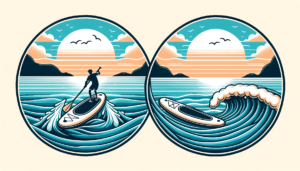When it comes to river paddleboarding, beginners often face a daunting task. But fear not, for there are tips to ensure a smooth and enjoyable experience.
Take, for example, Sarah, a novice paddleboarder who recently ventured onto the river. By following a few essential guidelines, Sarah was able to navigate the currents with ease, maintain balance on her board, and choose the perfect river for her paddleboarding adventure.
In this article, we will explore why beginners like Sarah should follow these invaluable tips.
Essential Gear for River Paddleboarding Beginners
The essential gear for river paddleboarding beginners includes a quality paddleboard, a paddle, a personal flotation device, and appropriate clothing.
When it comes to proper clothing for river paddleboarding beginners, it’s important to choose items that provide both comfort and protection. Opt for quick-drying materials that will keep you comfortable even if you get wet. Consider wearing a wetsuit or a rash guard to protect your skin from the sun and potential scrapes. A hat and sunglasses are also recommended to shield your eyes and face from the sun’s rays.
In addition to clothing, there are a few essential accessories that every river paddleboarding beginner should have. First and foremost, a quality paddleboard is crucial. Look for one that’s stable and durable, as this will make your experience on the water much more enjoyable. A suitable paddle is also necessary for propelling yourself forward and maneuvering through the currents. Don’t forget to wear a personal flotation device, even if you’re a strong swimmer. This will provide an added layer of safety in case of an accident.
Now that you have the essential gear and clothing, it’s time to move on to the next section: safety tips for navigating river currents. By following these tips, you can ensure a safe and enjoyable paddleboarding experience on the river.
Safety Tips for Navigating River Currents
To ensure a safe and enjoyable paddleboarding experience on the river, beginners should follow these safety tips for navigating river currents:
-
Understanding river rapids: Before venturing out onto the river, it’s crucial to have a good understanding of river rapids. Rapids can vary in intensity, and it’s important to know how to read the water and anticipate any obstacles or hazards that may come your way.
-
Paddleboarding in shallow waters: When navigating river currents, beginners should stick to shallow waters. This won’t only make it easier to maneuver through the currents but also provide a safer environment in case of any falls or accidents. It’s important to stay away from deep or fast-moving sections of the river, as they can be more challenging to navigate.
-
Wearing a life jacket: Safety should always be a top priority when paddleboarding on the river. Beginners should always wear a properly fitting life jacket to ensure their safety in case of any unexpected falls or accidents. A life jacket will provide buoyancy and keep you afloat even in fast-moving currents.
-
Using a leash: A leash is an essential safety accessory when paddleboarding on the river. It attaches you to your paddleboard, preventing it from drifting away if you fall off. This ensures that you stay connected to your board and can easily retrieve it, reducing the risk of getting separated from your board in the river currents.
Techniques for Maintaining Balance on the River
Beginners can improve their balance on the river by practicing specific paddleboarding techniques. One important aspect to focus on is core strength. Engaging the core muscles helps to stabilize the body and maintain balance on the unstable surface of the paddleboard. Incorporating core strength exercises into a regular fitness routine can greatly benefit paddleboarders. Exercises such as planks, Russian twists, and leg raises are effective for building core strength.
In addition to core strength, proper paddleboard positioning is crucial for maintaining stability in river conditions. Beginners should consider the placement of their feet on the board. Positioning the feet shoulder-width apart and slightly bending the knees can provide a stable base. It’s also helpful to distribute weight evenly on the paddleboard and keep the body centered.
To maintain balance on the river, it’s important to anticipate and adjust to changes in current and water movement. Beginners should actively engage their leg muscles to make small adjustments in their stance and paddleboard position. By staying flexible and responsive to the river conditions, paddleboarders can enhance their overall balance and stability.
With improved balance techniques, beginners will be better equipped to tackle different river challenges. Transitioning to the next section, it’s important for paddleboarders to choose the right river for their skill level and experience.
How to Choose the Right River for Paddleboarding
Paddleboarders should consider the river’s characteristics when choosing the right location for their paddleboarding experience. Each river has its own unique features that can greatly impact the overall paddleboarding experience. Here are some important factors to consider when selecting a river paddleboarding location:
-
Flow: Look for rivers with a gentle and steady flow, as strong currents can make it more difficult to navigate and maintain balance on a paddleboard.
-
Depth: Opt for rivers with a sufficient depth to avoid getting stuck or hitting rocks or other obstacles.
-
Access Points: Consider the availability of convenient access points, such as boat ramps or designated paddleboarding areas, to ensure an easy entry and exit from the river.
-
Scenery: Choose a river that offers breathtaking views and natural beauty. Paddleboarding on a scenic river can enhance the overall experience and provide a sense of freedom and tranquility.
Paddleboarding on rivers has numerous benefits. It allows individuals to connect with nature, explore new areas, and experience a sense of freedom and adventure. Rivers provide a serene and peaceful environment, away from the hustle and bustle of city life. Moreover, paddleboarding on a river offers a low-impact full-body workout, improving strength, balance, and cardiovascular health.
Common Mistakes to Avoid While River Paddleboarding
One common mistake that new river paddleboarders should avoid is underestimating the importance of proper safety precautions. When paddleboarding on a river, it’s essential to prioritize safety to ensure an enjoyable experience.
First and foremost, beginners should always wear a personal flotation device (PFD) to stay afloat in case of an accidental fall. Additionally, it’s crucial to be aware of the river’s current and water conditions before heading out. Checking the weather forecast and monitoring water levels can help prevent unexpected hazards.
Another mistake to avoid is neglecting paddleboarding techniques. Learning the proper paddleboarding stance and stroke techniques can significantly improve balance and maneuverability. Using the correct paddling technique, such as a forward stroke or sweep stroke, can help navigate the river more efficiently and conserve energy. Beginners should also practice turning and stopping techniques to ensure control while on the water.
Lastly, it’s essential to be mindful of the river’s flow and potential obstacles. Avoiding areas with strong currents or rapids beyond your skill level is crucial for safety. Additionally, be cautious of submerged rocks, fallen trees, or other debris that may pose a risk.
Frequently Asked Questions
What Are Some Good Exercises to Improve Balance for River Paddleboarding Beginners?
Exercises for balance improvement are essential for river paddleboarding beginners. They help build core strength and stability, which are crucial for maintaining balance on the water. Paddleboarding itself offers numerous benefits for overall fitness.
What Is the Optimum Paddle Length for River Paddleboarding?
When it comes to paddleboarding on rivers, choosing the right paddle length is crucial for efficient paddling. With various options available, beginners should consider their height and the type of paddling they plan to do.
Are There Any Restrictions or Permits Required for Paddleboarding on Certain Rivers?
Permits are often required for paddleboarding on certain rivers due to safety concerns. It is important for beginners to follow these tips to ensure their own safety and to comply with any regulations.
How Can Beginners Identify and Avoid Dangerous River Obstacles While Paddleboarding?
Beginners should follow these tips to identify and avoid dangerous river obstacles while paddleboarding. They need to stay alert and scan the water for potential hazards and learn how to read the current.
What Should Beginners Do if They Fall off Their Paddleboard in a Fast-Flowing River?
If a beginner falls off their paddleboard in a fast-flowing river, they should remain calm and try to swim to a safer area. Regular exercises for better balance can help prevent falls, while being knowledgeable about identifying river dangers is crucial for safety.

